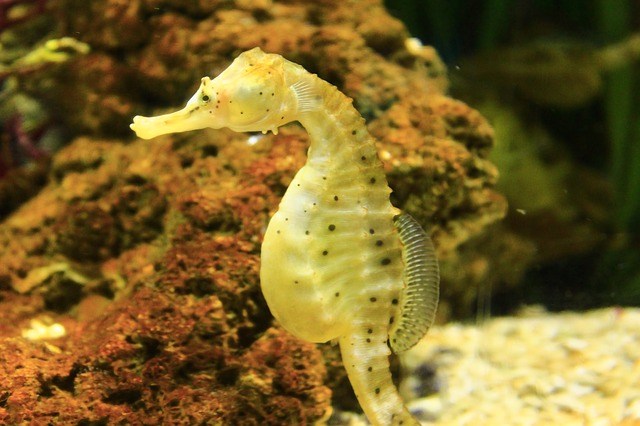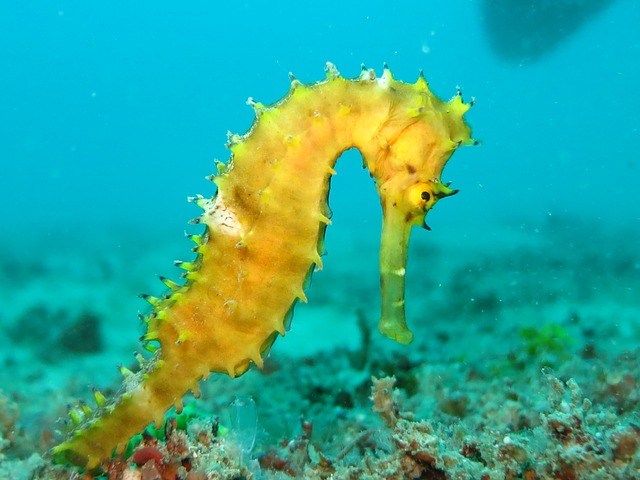When building aquariums, people love to have unique, colorful, and interesting fish for their tank. Well, what better way to make an impact than a few quirky little seahorses?
Most people recognize these fish at first glance, and almost everyone has heard of their unique reproductive systems, but how easy are they to keep and care for?
What do seahorses eat and how do you keep them healthy? With a little preparation, seahorse care can be just as easy as that of any other fish.
Contents
Seahorse Appearance and Personality
There are a lot of different seahorse species out there—47 of them in the wild!
While not all of these are available for your home aquarium, there’s still a variety available, and each species may have different requirements.
The most common horses are going to be between five to eight inches in height when full grown, and include the species Hippocampus erectus, Hippocampus reidi, and Hippocampus barbouri.
Size and Shape
Seahorses are easily recognizable by their unique shape, their prehensile tails, and their long snouts that give them their name. Depending on the species, they can live anywhere from one to four years.
Despite their odd shape, these creatures are fish, though relatively primitive ones. They don’t have a true stomach, but instead a very simple digestive system that moves food through quickly, so they must eat more frequently than normal fish.
Their gills are also less efficient. Seahorses also do not have scales like other fish, but instead, have skin-like tissue stretched over a bony exoskeleton.
Price
Seahorses themselves start at around $60 each with rare and special species of seahorses starting at $100. These prices will always vary depending on the retailer and type of seahorse you plan on purchasing.
Seahorse Care
Tank Requirements
Because of the way seahorses hold themselves, the height of the aquarium is just as important as the number of gallons of water needed.
The seahorse tank should be at least 18 inches high, and you should have about 20 gallons of water per seahorse.
Don’t forget when measuring the height of your tank to include an allowance for the substrate and decor—the 18-inch height should be after your substrate is added.
Seahorses prefer small crushed coral or sand for substrate and should be 2-2.5” deep to help accommodate any plants or décor that your seahorse will need to use as anchors. Don’t go overboard; too much substrate could cause food to fall in and decay, creating hydrogen sulphite which is fatal to your horses.
When it comes to your filter, seahorses are very weak swimmers, so make sure that your filter has a lower water flow. Because they also have weak gills, you need to make sure that the water is properly oxygenated, and they also have such quick digestive systems that they produce a lot of waste.
When setting up your tank, make sure that your filter, or filters, turn over the entire water volume in 3-4 hours. The best bet for a seahorse tank is a protein skimmer, which will not only remove organic matter efficiently, but it increases the oxygen content without disturbing the water too much.
Seahorses need something to wrap their prehensile tails around to keep themselves anchored, and to feel safe and secure. These are sometimes referred to as hitching posts for your horses.
Gorgonias are ideal for hitching posts, as well as corals (faux or otherwise) and kelp. You could also add macroalgae or seagrasses.
Many of these are protected and harder to find, and some are considered invasive species and are not able to be sold, so consult both your state regulations and your local fish store before you purchase. Live rock is great for seahorses, as long as it has been properly cleaned beforehand.
Basic lighting is fine for seahorses, and they don’t like as much light as a normal reef tank would have, so be careful if you plan on adding live coral which would need this stronger lighting. There are some species of coral that require less lighting than others, so talk with your local aquatic experts to pick the right ones.
Water Quality
As with all fish tanks, the water, substrate, and decorations should be cycled in the tank before fish are introduced.
The pH level should be between 8.1 and 8.3, and pH can be tested with any home test kit. The specific gravity should be maintained between 1.021 to 1.024.
You can use pre-mixed saltwater, or mix your own at home, but as always make sure that the water has been thoroughly dechlorinated and the bucket used to mix has never contained soap.
The temperature in the tank should stay between 74 and 76 degrees Fahrenheit. This is a cooler temperature than may other fish like, so make sure that you keep the tank out of direct sunlight and not exposed to extreme heat to help maintain the proper temperature.
If you live in a warmer climate, you may need to invest in a fan or a cooler to keep it cold enough for your seahorses.
Tank Set-Up
Seahorses do best in a new tank, or at least a refurbished one. Because they can be sensitive, it’s best to start a tank dedicated to their needs, rather than add them to an already established tank.
If you already have fish in your tank and want to add a seahorse, the best way to do so is in a quarantine tank first. This not only keeps a potentially sick fish away from the others, but it allows the new fish to get used to the water and food you are providing, reducing stress.
Before you remove your seahorse from quarantine, make sure that the tank has plenty of places for the seahorse to hide. Rearrange the current layout of your tank to distract the existing fish and remove any established territories.
Feed your current fish right before introducing the new one, which will make them less aggressive. It is also better to introduce more than one new fish at a time, as it reduces the chances of one new fish being singled out and aggravated.
And, as always, make sure you water is clean and appropriately balanced to reduce stress in all of the fish.
Here’s a video showing an example of a seahorse tank setup.
Tank Maintenance
Once a tank is set up and the horses are happy, water changes are the best way to maintain a healthy tank.
Smaller tanks require more frequent water changes because toxins such as ammonia and nitrates build up more quickly compared to larger tanks. Regular water changes and good filters are more important the smaller the tank.
Once a week, take out the filter and clean it, and change the tank water at least once a week. Replace 10-25% of the tank’s water each week, and make sure you check the temperature, specific gravity, and pH afterwards to maintain the healthy environment.
When you do a water change, wipe down the tank walls and decorations.
Because seahorses are so sensitive, be sure to check the filters daily to ensure that they are fully functional.
Check the water temperature daily as well, and run pH and salinity tests on a weekly basis (or if you notice any changes in your seahorse’s appearance or behavior).
Seahorse Food
Because seahorses have such a primitive digestive system, they go through food quickly. They should be fed at least twice a day.
Despite their small size, they are carnivores, and can eat frozen shrimp or krill. Place about 50 krill or six to eight mysis shrimp in the tank per seahorse, and then siphon off whatever they do not eat.
Any food left in the tank could sink to the bottom and begin to decay, creating toxic hydrogen sulphite. You can supplement their diet with live food as well as frozen.
If you don’t want to hand-feed your horses in this method, you can also set up a feeding station. Guide them over to the feeding station with one shrimp, and they should slurp down the rest themselves without fuss.
Soon they will learn where the food station is, and they will go there when they see you walk into the room.
Seahorse Tankmates
It can be hard finding appropriate seahorse tank mates. It is highly recommended that seahorses be kept in a tank only with other seahorses.
They are slow animals and can have a hard time competing for food with faster or more aggressive fish. Because they are also so delicate, they can be easily injured by other creatures. A lot of fish may also eat the seahorses.
However, if you want to add some variety to your tank, seahorses may be fine with peaceful creatures like snails, gobys, limpets, blennys, clownfish, and tangs.
If you are concerned which fish will match your horses, look for ones that are relatively inactive or slow swimmers so that they do not compete for food and swimming space.
It’s not a bad idea to include animals that can help keep your tank clean, such as brittle or serpent starfish, hermit crabs, sea cucumbers, or sea hares.
Beware of larger crabs that may grab onto seahorse tails, shrimp that may be eaten by the horses, or anemones which will sting and potentially kill them.
Health Concerns
Disease can be introduced to the tank when you add anything that has not been properly cleaned or quarantined, including live rock, corals, and fish.
The best prevention is proper care and cleaning of anything new going into the tank, as well as making sure that you provide quality food, good water, proper tank mates, and that the pH and specific gravity of the water is maintained.
The more stressed a fish is, the more likely they are to get sick.
Because of the seahorse’s odd skin, they are more prone to bacterial or viral infections. Keep an eye out for sores on their skin, or white, gray, or inflamed growths, as this is a sign of a problem.
Also look for other signs of disease, such as cloudy eyes, heavy breathing, panting or coughing, and bloating. If you see any of these symptoms in your horses, confer with your local vet or aquatics expert for treatment.
The sooner you catch problems, the more likely your seahorse will recover promptly.
Do you own a seahorse?






